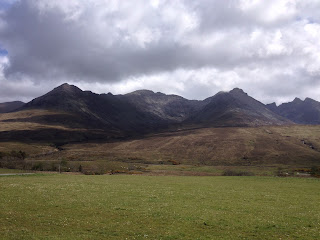Mixed fortunes
Mother Nature moves in many ways, reflected in recent weeks by the fortunes of the young birds and around our home.
Our Swallow pair, as mentioned in the last blog, produced three chicks. However a couple of days after hatching, we saw almost three days of continuous rain - a real rarity in these parts, despite what most uninformed folk think about 'Scottish weather'. The lack of flying insects in such weather, plus the parent birds themselves getting wet and returning to the nest, this chilling the chicks, all combined to mean the youngsters were shortlived. A real shame, but it's only nature.
Ospreys - busy right now feeding their families
At the other end of the scale, in terms of size and fortune, are our local Osprey chicks. The two nearest nests to us both have good sized chicks, and is testimony to the new parenting team on both. The closest nest has a new female (who replaced the late Green 5B, known as 'Beatrice' to those that followed her satellite-tracked movements), whilst the other nest has a new male - an older bird who kicked out the young male late last summer and returned this year. This particular nest was the first identified in Moray since the recolonisation of Ospreys, and this year marks 50 years of occupancy. It won't be long until we can expect to see the chicks 'helicoptering' above the nest as they prepare to take flight for the first time.
Quiet on the moors
Not surprisingly, the weather also put paid to some of nesting or brooding attempts of some of the moorland species; I saw a group of over 30 adult Curlews in recent weeks, a sure sign that something had gone wrong with their breeding efforts.
Short-eared Owl listening and watching for food
The weather, however, is not to blame for the lack of field voles this year. This wee mammal has a four year cycle, with population numbers varying tenfold between their highest and lowest points. As a result, Short-eared Owl numbers are down in the areas where I tend to watch them, and those that are breeding will probably fledge smaller broods (sibling cannabalism being the extreme to survive) due scarcity of their staple food.
Golden rings
Back to Ospreys...my favourite bird as you probably know! 2016 marks the 50th anniversary of Ospreys being ringed in the UK. The colour rings were introduced to identify birds at a distance, with suitable optics of course, in order to study their behaviour. As camera technology entered the digital age, more and more records of colour ringed Ospreys were reported thus building an even greater picture. Our friend Roy Dennis has been ringing Ospreys since those early days in 1966, and co-ordinates UK ringing to this day as part of his conservation work under his charity the Highland Foundation for Wildlife (see www.roydennis.org, and feel free to make a donation towards his work).
As a birder, ringed Ospreys mean that you can identify familiar faces year on year. So, as Osprey ringing season is well underway at the moment, here's a wee photo tribute showing some of the ringed birds that have passed my lens in recent years:
Blue AH
Blue AU6
Blue CL6
Blue DF at ringing
Blue XD
Blue XE
Green 2E
Red 8T
White EJ
Yellow 9A
Happy birding!
Mike
A9Birds is a birdwatching and wildlife photography company based in Moray, covering the local area including Strathspey, the Moray Firth and Inverness-shire. Please see our website for details of what we can offer you, and why not keep up to date with our sightings and photos on our Facebook page. All photos on this page are copyright Mike Crutch/A9Birds.
















Comments
Post a Comment